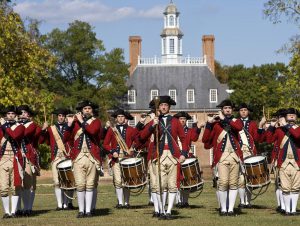If you are looking to visit top historic destinations, Williamsburg has plenty to offer. We have listed some of the best historic sites for you to plan the perfect visit to Williamsburg.
-
 Colonial Williamsburg
Colonial WilliamsburgThe best place to start with this outdoor museum is at the visitor center. A film and an orientation walk are informative and will save you time. There is so much to see here – buildings, gardens, taverns, trade shops and demonstrations – that it is virtually impossible to see it all in a day or even two. The mini-city is laid out well (think of an 18th-century Disney World), and walking the area is a pleasure. Evening events are held during the summer, so be sure and check those out. Extended summer hours.
-
The College of William and Mary
The easiest way to explore this college is to get a map (available on campus or at www.wm.edu) and start off on a self-directed tour. Wandering around the school is also an option – the students are not only bright (Phi Beta Kappa was founded here), they are also polite and helpful. For the second oldest college in the country, this place looks fantastic. This is an elegant site full of living history so don’t miss it. There are numerous cultural and arts events held on campus – check out a schedule while you are visiting.
-
Westover Plantation
Situated on the James River, Westover is touted as one of the finest examples in the country of Georgian architecture. The house was built in 1730 by William Byrd, the man who founded Richmond. The property also includes burial grounds that hold his final resting place. Not far from the house is the third oldest tombstone in the country – that of Captain William Perry, who died in 1637. The grounds are home to an elegant boxwood garden and ancient tulip poplars. The house is not open to the public except during Virginia Garden week.
-
Belle Air Plantation
Although the house is open by appointment only to groups of 20 or more, it is worth calling to see if you can tag along with a tour. The large frame house, built in 1650, is a study in how life was lived in that time, and the architecture is outstanding and unique. The gardens are exquisite and are also open for tours by appointment. During Historic Garden week, held each year at the end of April, both the gardens and the house are open to the public.
-
Edgewood Plantation
Originally part of Berkeley Plantation and complete with its own broken-hearted ghost, Edgewood is a 7,000-square-foot Gothic Revival house that is now operated as a bed and breakfast. But tours can be arranged – the Victorian Tea Tour and the Candlelight Tour are two of the most popular. They require at least 10 people, so call ahead. This is a popular stop during the Christmas season as more than 15 Victorian Christmas trees decorate the house.
-
North Bend Plantation
One of the best-preserved examples of Greek Revival houses in the area, this plantation originated as home to President William Henry Harrison’s sister. Currently owned by the great, great grandson of the Ruffin family (owners of Evelynton Plantation), it is run as a bed and breakfast. But day and evening tours are available by appointment. You do not need an appointment for the grounds tour – it is on the honor system and costs $2.
-
Sherwood Forest Plantation
A working plantation and former home to the 10th president of the United States, John Tyler, this site is still occupied by the Tyler family. The home is said to be the longest frame house in the US – 300 feet; part of that length includes the 68-foot ballroom where the Virginia Reel was danced. The home is furnished with period antiques, and many of President Tyler’s personal items are on display. There is an excellent gift shop on the premises. The plantation is about a 20-minute drive from Williamsburg.
-
Piney Grove at Southall’s Plantation
Listed on the National Register of Historic Places, this Charles City landmark was a 300-plus-acre Tidewater plantation owned by the Southall family on land once occupied by the Chickahominy people. In fact, Piney Grove stands as one of the best remaining examples of Early Virginia log architecture. Today, visitors to the plantation will find Duck Church (built in 1917) and three historic homes: Ashland (1835); Dower Quarter (1835); and Ladysmith (1857). Open to the public are the plantation’s lovely grounds, which include gardens and nature trails. Those wishing to stay overnight may book a room in the Ladysmith House, which operates as a bed and breakfast.
-
Jamestown Settlement
View replicas of the three ships and a fort occupied by the first settlers to arrive at Jamestowne in 1610. Historians, dressed in authentic period clothing, walk the grounds and are happy to answer your questions about life at the settlement. Visit the indoor gallery to see 30-minute documentary film and exhibits that document the lives of the English settlers, Powhatan Indians and African slaves who occupied the colony.
